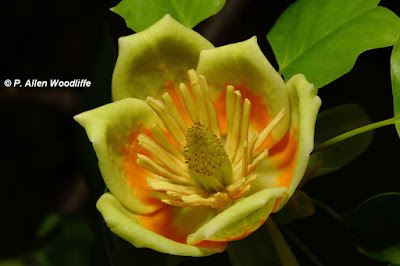The peak of the spring bird migration has now passed and resident species are settling down to nest. The forests of Rondeau can be full of bird song at various times of day. At other times it is relatively quiet, but there are other things to take note of. While I was on the boardwalk near where the Prothonotary Warblers are nesting, this Five-lined Skink approached me. It came to within about half a metre of my foot before it scampered off in the other direction.
Just over the edge of the boardwalk, this Green Frog was resting, appropriately, amongst Frog-bit....it is the circular plant on the frog's back. Frog-bit is not native, but showed up at Rondeau in the marsh back in the mid-1970s and has been expanding to quiet waterways ever since. The tiny floating plants are one of the three species of duckweed that occur at Rondeau, and the tiniest floating plants in this image are Watermeal.
At ground level in the forest are plants such as this Canada Violet, one of two species of white violets occurring at Rondeau. The other species is almost finished flowering now.
Another flowering plant which is quite abundant in the richer part of the forest is Sweet Cicely. The individual flowers are quite small. In a few weeks you will hardly notice the plant at all, but a bit later you will notice them for an uncomfortable reason: if you are walking off the trail, you will end up with sharp pointed black seeds stuck into your socks or pants, poking into your skin. As you pull the seeds out, you are dispersing them to perhaps a new area.
 |
| Sweet Cicely |
.....and a Snapping Turtle. One doesn't often see snappers in the sloughs, but they are there.
There are a lot of Tuliptrees at Rondeau....it is the unofficial flagship tree species for the park, as it is the largest provincial park in the Carolinian Life Zone which Tuliptrees are more or less limited to in Canada. Appropriately there is even a trail with that name. One of the highlights at this time of year is to see the numerous flowers on these trees. Unfortunately the flowers are typically very high up in the tree, since they require a lot of light. There are a few open grown Tuliptrees, and where you find them, there are lower branches which often have flowers. Two of the best spots to see them at about eye level are in the campground (not far from site 71) and at the north end of the parking lot for the Marsh Trail.
Some of the flowers will have pollinators visiting, such as this honey bee in the image below.
There are still birds to be heard and seen. Acadian Flycatchers have one of their Canadian strongholds at Rondeau, and there are currently at least 4-5 known singing males or pairs right along the trails or roads. Who knows how many are back in the less accessible part of the forest.
In more open areas of the forest, one may come encounter an Orchard Oriole, another southern species. The black and chestnut brown pattern of the adult male are unmistakable.
Butterflies are becoming more abundant. There were several Spicebush Swallowtails, appropriately, at the Spicebush Trail parking lot.
Question Mark butterflies are also fairly widespread.
At the Visitor Centre, a Blue Jay was taking a bath, apparently unconcerned who was watching and photographing the event.
Near Shrewsbury, there is a small colony of Great Blue Herons nesting in a half-dead willow tree. These shots were taken from the marsh edge, but I hope to get the kayak out one of these days and get different shots.
 |
| Adult heron approaching the nest tree |
 |
| Arriving at the nest, the adults greet each other |
The Blenheim Sewage Lagoons are always good for a different diversity of wildlife. The sprinkler cells vary in their condition from one visit to the next. On occasion hundreds of shorebirds, especially Dunlin, are present. But mixed in may be some much rarer shorebirds, such as this White-rumped Sandpiper.
For some reason, a lone Tundra Swan is still present at the lagoon. Presumably it cannot fly.
Not that long ago, I had a Cattle Egret in breeding plumage arrive at the lagoon, circle around a bit and then land in the grassy area.
In an unmowed part of the lagoon, I flushed out a small sparrow.
Given the way it allowed me to get very close before flushing, I assumed it had a nest nearby and so upon closer examination I discovered this nest of three hatchlings and two eggs.




















No comments:
Post a Comment